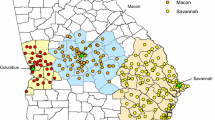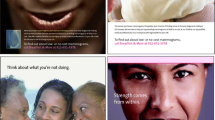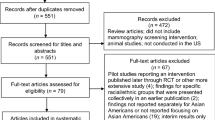Abstract
This study developed and examined the reach and impact of a culturally appropriate mass media campaign pilot, designed to increase awareness about the importance of mammography screening and the available community mammography services for low-income African American women ages 40 and above. We conducted formative research using focus groups to inform campaign development, resulting in five emergent themes—good breast health, holistic views of healthiness, cancer fatalism, fear of mammogram machines, and mammogram affordability. The campaign targeted specific low-income African American communities in the District of Columbia via print ads in Metro stations and on buses, print ads in the Washington Informer, and online ads on a local TV network website. Data were collected before, during, and after campaign implementation to assess reach and impact. Reach was measured by number of impressions (number of people exposed to the campaign), while impact was assessed via online ad click-through rates, website use and referrals, and mammography center calls. The campaign was successful in reaching the target audience, with a total combined reach from all media of 9,479,386 impressions. In addition, the mammography center received significant increases in new website visitors (1482 during the campaign, compared to 24 during the preceding period) as well as 97 calls to the dedicated phone line. Further research involving a more long-term investment in terms of funding and campaign run time, coupled with a more robust evaluation, is needed to assess if culturally appropriate mass media campaigns can generate increased mammography screening rates and decrease breast-cancer-related mortality.
Similar content being viewed by others
References
U.S. Preventative Services Task Force. (2016). Final update summary: Breast cancer: Screening. Retrieved from https://www.uspreventiveservicestaskforce.org/Page/Document/UpdateSummaryFinal/breast-cancer-screening.
Hunt, B. R., Whitman, S., & Hurlbert, M. S. (2014). Increasing Black:White disparities in breast cancer mortality in the 50 largest cities in the United States. Cancer Epidemiology, 38(2), 118–123. https://doi.org/10.1016/j.canep.2013.09.009.
Siegel, R. L., Miller, K. D., & Jemal, A. (2017). Cancer statistics, 2017. CA: A Cancer Journal for Clinicians, 67(1), 7–30. https://doi.org/10.3322/caac.21387.
District of Columbia Department of Health. (2014). Burden of cancer in the District of Columbia. Washington, DC: Government of the District of Columbia.
U.S. Census Bureau. (2016). Quick facts: District of Columbia. Retrieved from https://www.census.gov/quickfacts/fact/table/DC/PST045216.
Basch, C. H., Hillyer, G. C., MacDonald, Z. L., Reeves, R., & Basch, C. E. (2015). Characteristics of YouTube videos related to mammography. Journal of Cancer Education: The Official Journal of the American Association for Cancer Education, 30(4), 699–703. https://doi.org/10.1007/s13187-014-0769-9.
Jensen, J. D., Krakow, M., John, K. K., & Liu, M. (2013). Against conventional wisdom: When the public, the media, and medical practice collide. BMC Medical Informatics and Decision Making, 13(Suppl 3), S4. https://doi.org/10.1186/1472-6947-13-S3-S4.
Mayer, J. A., Kossman, M. K., Miller, L. C., Crooks, C. E., Slymen, D. J., & Lee, C. D. Jr. (1992). Evaluation of a media-based mammography program. American Journal of Preventive Medicine, 8(1), 23–29.
Weeks, B. E., Friedenberg, L. M., Southwell, B. G., & Slater, J. S. (2012). Behavioral consequences of conflict-oriented health news coverage: The 2009 mammography guideline controversy and online information seeking. Health Communication, 27(2), 158–166. https://doi.org/10.1080/10410236.2011.571757.
Yanovitzky, I., & Blitz, C. L. (2000). Effect of media coverage and physician advice on utilization of breast cancer screening by women 40 years and older. Journal of Health Communication, 5(2), 117–134. https://doi.org/10.1080/108107300406857.
Kiviniemi, M. T., & Hay, J. L. (2012). Awareness of the 2009 US Preventive Services Task Force recommended changes in mammography screening guidelines, accuracy of awareness, sources of knowledge about recommendations, and attitudes about updated screening guidelines in women ages 40–49 and 50+. BMC Public Health, 12, 899. https://doi.org/10.1186/1471-2458-12-899.
Fulton, J. P., Feldman, J. P., Donnelly, E. F., et al. (1992). Evaluating a mass media campaign to promote screening mammography in Rhode Island. Rhode Island Medicine, 75(1), 9–15.
Hall, I. J., Johnson-Turbes, A., Berkowitz, Z., & Zavahir, Y. (2015). The African American Women and Mass Media (AAMM) campaign in Georgia: Quantifying community response to a CDC pilot campaign. Cancer Causes and Control: CCC, 26(5), 787–794. https://doi.org/10.1007/s10552-015-0540-5.
Hall, I. J., & Johnson-Turbes, A. (2015). Use of the persuasive health message framework in the development of a community-based mammography promotion campaign. Cancer Causes & Control: CCC, 26(5), 775–784. https://doi.org/10.1007/s10552-015-0537-0.
Witte, K. (1995). Fishing for success using the persuasive health message framework to generate effective campaign messages. In E. W. Maibach & R. L. Parrott (Eds.), Designing health messages: Approaches from communication theory and public health practice (pp. 145–166). Thousand Oaks, CA: Sage.
Kotler, P., & Armstrong, G. (2009). Principles of marketing. Upper Saddle River, NJ: Prentice Hall.
Mann, J. J., Apter, A., Bertolote, J., et al. (2005). Suicide prevention strategies: A systematic review. JAMA, 294(16), 2064–2074. https://doi.org/10.1001/jama.294.16.2064.
Wakefield, M. A., Loken, B., & Hornik, R. C. (2010). Use of mass media campaigns to change health behaviour. Lancet, 376(9748), 1261–1271. https://doi.org/10.1016/S0140-6736(10)60809-4.
Bala, M. M., Strzeszynski, L., Topor-Madry, R., & Cahill, K. (2013). Mass media interventions for smoking cessation in adults. Cochrane Database of Systematic Reviews. https://doi.org/10.1002/14651858.CD004704.pub3.
Robinson, M. N., Tansil, K. A., Elder, R. W., et al. (2014). Mass media health communication campaigns combined with health-related product distribution: A community guide systematic review. American Journal of Preventive Medicine, 47(3), 360–371. https://doi.org/10.1016/j.amepre.2014.05.034.
Cain, K. (2012). Measuring marketing effectiveness: 6 metrics you need to track. Retrieved from Content Marketing Institute Website: http://contentmarketinginstitute.com/2012/10/measuring-marketing-effectiveness-metrics/.
Randolph, W., & Viswanath, K. (2004). Lessons learned from public health mass media campaigns: Marketing health in a crowded media world. Annual Review of Public Health, 25, 419–437. https://doi.org/10.1146/annurev.publhealth.25.101802.123046.
Centers for Disease Control and Prevention (2007). Youth media campaign: VERB. Retrieved from https://www.cdc.gov/youthcampaign/.
Reger, B., Cooper, L., Booth-Butterfield, S., et al. (2002). Wheeling walks: A community campaign using paid media to encourage walking among sedentary older adults. Preventive Medicine, 35(3), 285–292. https://doi.org/10.1006/pmed.2002.1074.
Agostinelli, G., & Grube, J. W. (2002). Alcohol counter-advertising and the media. A review of recent research. Alcohol Research & Health: The Journal of the National Institute on Alcohol Abuse and Alcoholism, 26(1), 15–21.
Reger, B., Wootan, M. G., & Booth-Butterfield, S. (1999). Using mass media to promote healthy eating: A community-based demonstration project. Preventive Medicine, 29(5), 414–421. https://doi.org/10.1006/pmed.1998.0570.
Grossman, D. C., & Garcia, C. C. (1999). Effectiveness of health promotion programs to increase motor vehicle occupant restraint use among young children. American Journal of Preventive Medicine, 16(1 Suppl), 12–22.
Myhre, S. L., & Flora, J. A. (2000). HIV/AIDS communication campaigns: Progress and prospects. Journal of Health Communication, 5 Suppl, 29–45. https://doi.org/10.1080/108107300126731.
Acknowledgements
This study was supported by funding from the Susan G. Komen Foundation (#NCR15CAPBCC) awarded to Dr. Lucile L. Adams-Campbell. The authors gratefully acknowledge Harrison Maldonado Associates, Inc., who assisted with the development of the campaign promotional pieces, and the many women from DC communities who participated in the formative focus groups. In addition, the authors declare that they have no conflicts of interest and no financial disclosures to report.
Author information
Authors and Affiliations
Corresponding author
Rights and permissions
About this article
Cite this article
Wallington, S.F., Oppong, B., Iddirisu, M. et al. Developing a Mass Media Campaign to Promote Mammography Awareness in African American Women in the Nation’s Capital. J Community Health 43, 633–638 (2018). https://doi.org/10.1007/s10900-017-0461-1
Published:
Issue Date:
DOI: https://doi.org/10.1007/s10900-017-0461-1




